人教版(2019)必修 第一册Unit 4 Natural disasters Reading and Thinking 课件(共19张PPT)
文档属性
| 名称 | 人教版(2019)必修 第一册Unit 4 Natural disasters Reading and Thinking 课件(共19张PPT) | 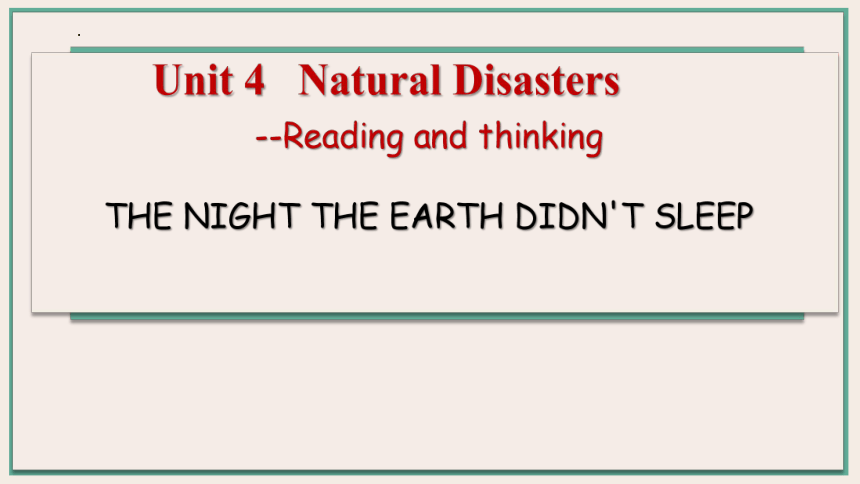 | |
| 格式 | pptx | ||
| 文件大小 | 8.9MB | ||
| 资源类型 | 教案 | ||
| 版本资源 | 人教版(2019) | ||
| 科目 | 英语 | ||
| 更新时间 | 2023-11-30 10:55:27 | ||
图片预览

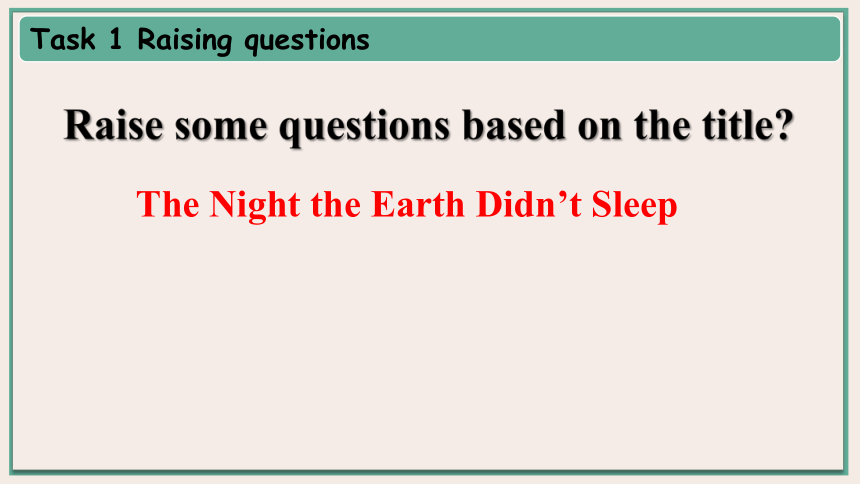

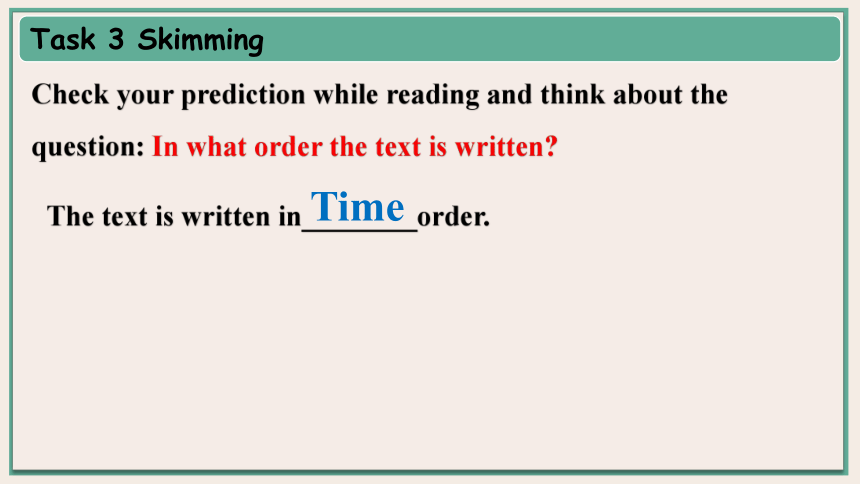
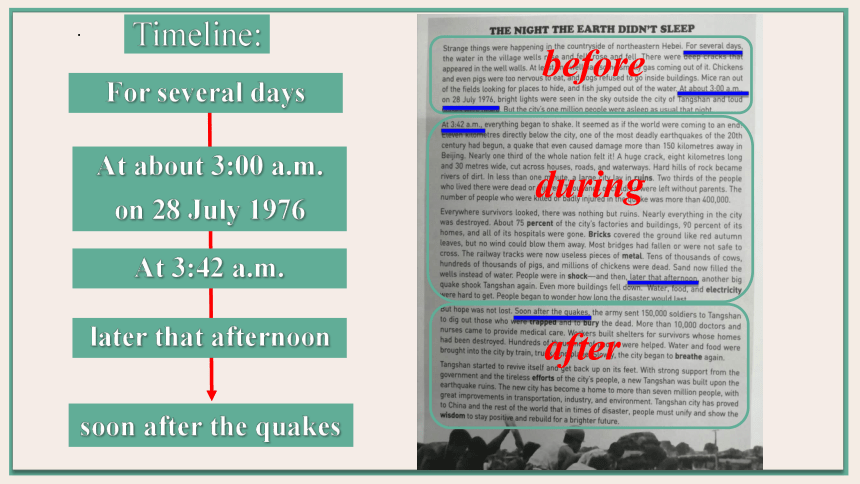
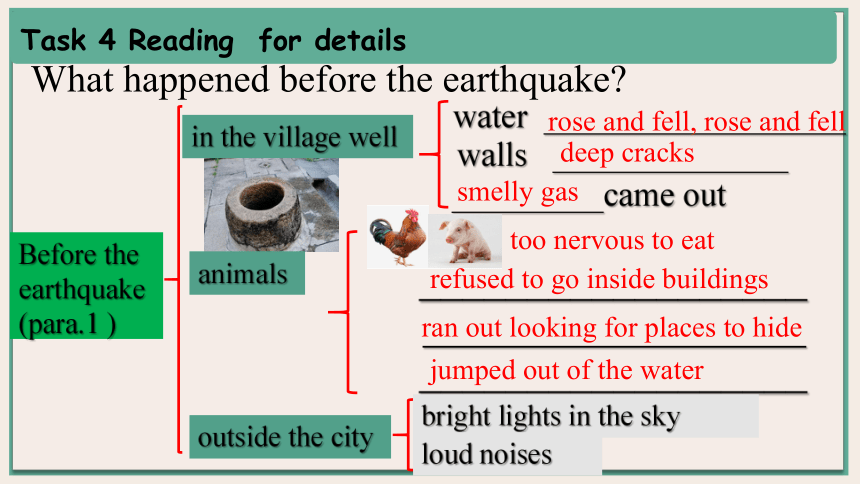
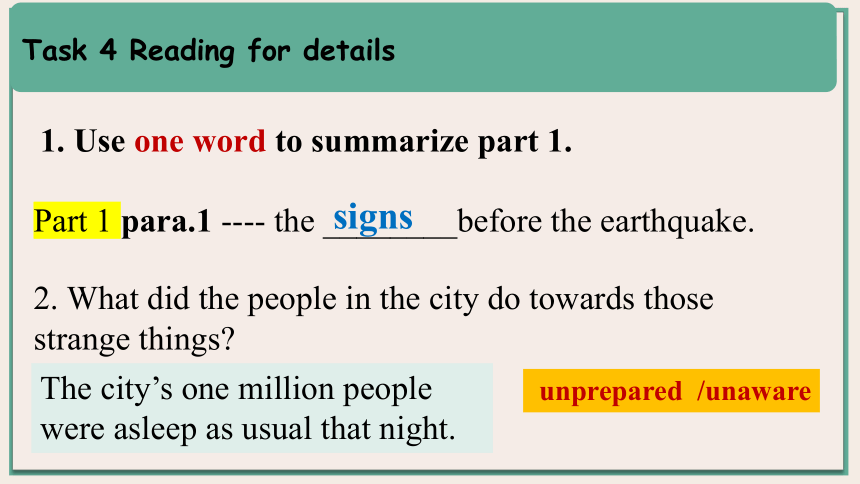
文档简介
(共19张PPT)
Unit 4 Natural Disasters
--Reading and thinking
THE NIGHT THE EARTH DIDN'T SLEEP
Raise some questions based on the title
The Night the Earth Didn’t Sleep
Task 1 Raising questions
The Night the Earth didn’t Sleep
Look at the title and the picture and guess why the earth didn’t sleep well that night
A terrible earthquake struck at night.
Task 2 Predicting
Check your prediction while reading and think about the question: In what order the text is written
Task 3 Skimming
The text is written in________order.
Time
later that afternoon
soon after the quakes
For several days
At about 3:00 a.m.
on 28 July 1976
At 3:42 a.m.
before
during
after
Timeline:
Task 4 Reading for details
What happened before the earthquake
Before the earthquake
(para.1 )
in the village well
animals
outside the city
water __________________
walls ______________
_________came out
__________________
____________________
__________________
rose and fell, rose and fell
deep cracks
smelly gas
too nervous to eat
refused to go inside buildings
ran out looking for places to hide
jumped out of the water
bright lights in the sky
loud noises
Task 4 Reading for details
Part 1 para.1 ---- the ________before the earthquake.
2. What did the people in the city do towards those strange things
unprepared /unaware
signs
1. Use one word to summarize part 1.
The city’s one million people were asleep as usual that night.
Task 4 Reading for details
1.What happened during and after the earthquake Create your own mind map.
During the earthquake
(para.2-3 )
city
animals
people
...
After the earthquake
(para.4-5 )
people
supplies
...
2. Fill in the data(数据) in para 2-3
1) _________of the nation felt the earthquake .
2) A huge crack that was____kilometres long and _____ metres wide cut across houses.
3) In less than ____ minute, a large city lay in ruins.
4)__________of the people died or were injured during the earthquake.
5) The number of people who were killed or injured reached more than__________ .
6) _____of its factories and buildings, _____ of its homes and all of the city's hospitals were gone.
One third
8
30
1
Two thirds
400,000
75%
90%
Why did the author use so many numbers
To show the earthquake was very serious and it caused a lot of damage to people and the city.
Task 4 Reading for details
Find out some sentences which contain the following figures of speech(修辞):exaggeration(夸张), simile(比喻),
and personfication(拟人). How do you interpret them and why does the author use them
Task 3 Reading for details
1. It seemed as if the world were coming to an end!
2. Bricks covered the ground like red autumn leaves, but no wind could blow them away.
3. Slowly, the city began to breathe again.
Task 4 Reading for details
1. It seemed as if the world were coming to an end! (exaggeration)
Task 4 Reading for details
2. Bricks covered the ground like red autumn leaves, but no wind could blow them away. (simile)
Task 4 Reading for details
3. Slowly, the city began to breathe again. (personification)
Using figures of speech can make the passage vivd and express some meanings convincingly, clearly and easily.
Task 4 Reading for details
Part 2 para.2-3 ---- the ________during the earthquake.
5. How did the people feel during and after the earthquake
shocked, hopeless, frightened, helpless...
damage
4. Use one word to summarize part 2 and part 3.
Part 3 para.4-5 ---- the __________________after the earthquake.
rescue and revival
hopeful, positive
1. What makes Tangshan revive so fast
Task 5 Dicussion
1. What makes Tangshan revive so fast
Task 5 Dicussion
unity
nameless heroes
immediate action
tireless efforts
yearning for revival
2. What lessons can we learn from the earthquake in Tangshan
Task 5 Dicussion
We should respect nature and obey its rules.
We need to know the warning signs of different natural disasters to reduce mortality(伤亡).
We need to know how to protect ourselves when natural disasters happen.
In times of disaster, people must unify and show the wisdom to stay positive and rebuild for a brighter future.
Life is weak, but if people unify, disasters can be defeated.
Unit 4 Natural Disasters
--Reading and thinking
THE NIGHT THE EARTH DIDN'T SLEEP
Raise some questions based on the title
The Night the Earth Didn’t Sleep
Task 1 Raising questions
The Night the Earth didn’t Sleep
Look at the title and the picture and guess why the earth didn’t sleep well that night
A terrible earthquake struck at night.
Task 2 Predicting
Check your prediction while reading and think about the question: In what order the text is written
Task 3 Skimming
The text is written in________order.
Time
later that afternoon
soon after the quakes
For several days
At about 3:00 a.m.
on 28 July 1976
At 3:42 a.m.
before
during
after
Timeline:
Task 4 Reading for details
What happened before the earthquake
Before the earthquake
(para.1 )
in the village well
animals
outside the city
water __________________
walls ______________
_________came out
__________________
____________________
__________________
rose and fell, rose and fell
deep cracks
smelly gas
too nervous to eat
refused to go inside buildings
ran out looking for places to hide
jumped out of the water
bright lights in the sky
loud noises
Task 4 Reading for details
Part 1 para.1 ---- the ________before the earthquake.
2. What did the people in the city do towards those strange things
unprepared /unaware
signs
1. Use one word to summarize part 1.
The city’s one million people were asleep as usual that night.
Task 4 Reading for details
1.What happened during and after the earthquake Create your own mind map.
During the earthquake
(para.2-3 )
city
animals
people
...
After the earthquake
(para.4-5 )
people
supplies
...
2. Fill in the data(数据) in para 2-3
1) _________of the nation felt the earthquake .
2) A huge crack that was____kilometres long and _____ metres wide cut across houses.
3) In less than ____ minute, a large city lay in ruins.
4)__________of the people died or were injured during the earthquake.
5) The number of people who were killed or injured reached more than__________ .
6) _____of its factories and buildings, _____ of its homes and all of the city's hospitals were gone.
One third
8
30
1
Two thirds
400,000
75%
90%
Why did the author use so many numbers
To show the earthquake was very serious and it caused a lot of damage to people and the city.
Task 4 Reading for details
Find out some sentences which contain the following figures of speech(修辞):exaggeration(夸张), simile(比喻),
and personfication(拟人). How do you interpret them and why does the author use them
Task 3 Reading for details
1. It seemed as if the world were coming to an end!
2. Bricks covered the ground like red autumn leaves, but no wind could blow them away.
3. Slowly, the city began to breathe again.
Task 4 Reading for details
1. It seemed as if the world were coming to an end! (exaggeration)
Task 4 Reading for details
2. Bricks covered the ground like red autumn leaves, but no wind could blow them away. (simile)
Task 4 Reading for details
3. Slowly, the city began to breathe again. (personification)
Using figures of speech can make the passage vivd and express some meanings convincingly, clearly and easily.
Task 4 Reading for details
Part 2 para.2-3 ---- the ________during the earthquake.
5. How did the people feel during and after the earthquake
shocked, hopeless, frightened, helpless...
damage
4. Use one word to summarize part 2 and part 3.
Part 3 para.4-5 ---- the __________________after the earthquake.
rescue and revival
hopeful, positive
1. What makes Tangshan revive so fast
Task 5 Dicussion
1. What makes Tangshan revive so fast
Task 5 Dicussion
unity
nameless heroes
immediate action
tireless efforts
yearning for revival
2. What lessons can we learn from the earthquake in Tangshan
Task 5 Dicussion
We should respect nature and obey its rules.
We need to know the warning signs of different natural disasters to reduce mortality(伤亡).
We need to know how to protect ourselves when natural disasters happen.
In times of disaster, people must unify and show the wisdom to stay positive and rebuild for a brighter future.
Life is weak, but if people unify, disasters can be defeated.
